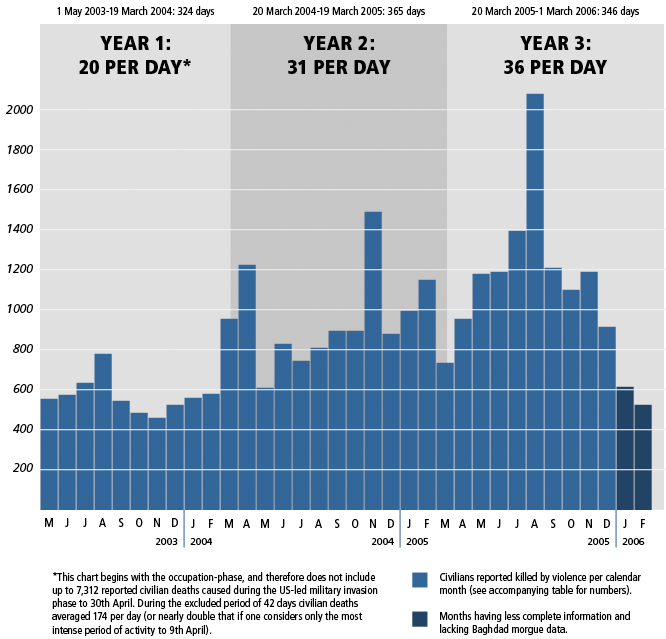Press Release 13 9 Mar 2006
Iraq death toll in third year of occupation is highest yet
The civilian death toll has risen inexorably for the entire duration of the US-led military presence in Iraq following the initial invasion. That is the grim reality uncovered by ongoing tracking of media reports by the Iraq Body Count project (IBC).
Figures released by IBC today, updated by statistics for the year 2005 from the main Baghdad morgue, show that the total number of civilians reported killed has risen year-on-year since May 1st 2003 (the date that President Bush announced “major combat operations have ended”):
- 6,331 from 1st May 2003 to the first anniversary of the invasion, 19th March 2004 (324 days: Year 1)
- 11,312 from 20th March 2004 to 19th March 2005 (365 days: Year 2)
- 12,617 from 20th March 2005 to 1st March 2006 (346 days: Year 3).
In terms of average violent deaths per day this represents:
- 20 per day in Year 1
- 31 per day in Year 2 and
- 36 per day in Year 3.
The IBC figure for Year 3 includes no deaths from March 2006, excludes the bulk of killings which followed the 22nd February bombing of a major Shiite Muslim shrine in Samarra, and lacks Baghdad morgue data for January and February this year. If January and February 2006 are excluded as being clearly incomplete, then the daily death rate for the remaining part of Year 3 rises to 40 (11,480 deaths over 287 days = 40 per day). However even before Year 3 has ended, and with incomplete data for its final months, the number of civilians reported killed is already higher than for all of Year 2 (12,617 vs. 11,312).
Although what has been described as ‘sectarian violence’ undoubtedly contributes to a growing proportion of deaths, the last year’s total includes 370 known civilian deaths from military action by US-led forces and 2,231 from anti-occupation activity against coalition and Iraqi government targets. The post-invasion increase in criminal activity remains an important concern, but the majority of media reports do not allow a clear identification of the perpetrators or their motives. The “unknown agents” who did most of the killing could fall into any of the categories above, as well as other types of ‘terrorist.’ Reports also indicate that the past year has seen an increasing number of extra-judicial executions.
Speaking from London, Iraq Body Count cofounder John Sloboda said, “Today’s figures are an indictment of three years of occupation, which continues to make the lives of ordinary Iraqis worse, not better. Talk of civil war is a convenient way for the US and Iraqi authorities to mask the real and continuing core of this conflict, which is between an incompetent and brutal occupying power on the one hand and a nationalist insurgency fuelled by grief, anger, and humiliation on the other. This conflict is proof that violence begets more violence. The initial act that sparked this cycle of violence is the illegal US-led invasion of March and April 2003 which resulted in 7,312 civilian deaths and 17,298 injured in a mere 42 days. The insurgency will remain strong so long as the US military remains in Iraq, and ordinary Iraqi people will have more death and destruction to look forward to.”
Iraq Body Count cofounder Hamit Dardagan added: “In September 2003, after our first major review of civil insecurity in Iraq informed by data from the Baghdad morgue, we noted that:
‘The US may be effective at waging war but the descent of Iraq’s capital city into lawlessness under US occupation shows that it is incompetent at maintaining public order and providing security for the civilian population. The US has toppled Saddam and discovered that it won't be discovering any weapons of mass destruction in Iraq. So why is it still there? And if the US military can’t ensure the safety of Iraqi civilians and itself poses a danger to them, what is its role in that country?’1
1 IBC Press Release 5 (23 Sep 2003)
“The question still stands, and Iraqis are still being killed in increasing numbers. How many more must die before the architects of the ‘military solution’ for Iraq realise that the only sure way to reduce violence is to stop inflicting it?”
Civilians reported violently killed per month

| 2003 | 2004 | 2005 | 2006 | |||||||
|---|---|---|---|---|---|---|---|---|---|---|
| Month* | Number Killed |
Month | Number Killed |
Month | Number Killed |
Month | Number Killed** |
|||
| Jan | 562 | Jan | 993 | Jan | 613 | |||||
| Feb | 580 | Feb | 1148 | Feb | 524 | |||||
| Mar | 953 | Mar | 734 | |||||||
| Apr | 1227 | Apr | 955 | |||||||
| May | 554 | May | 612 | May | 1181 | |||||
| Jun | 573 | Jun | 829 | Jun | 1188 | |||||
| Jul | 633 | Jul | 746 | Jul | 1393 | |||||
| Aug | 781 | Aug | 812 | Aug | 2078 | |||||
| Sep | 543 | Sep | 893 | Sep | 1211 | |||||
| Oct | 485 | Oct | 894 | Oct | 1100 | |||||
| Nov | 460 | Nov | 1490 | Nov | 1192 | |||||
| Dec | 524 | Dec | 882 | Dec | 916 | |||||
*This table begins with the occupation-phase, and therefore does not include up to 7,312 reported civilian deaths caused during the US-led military invasion phase to 30th April. During the excluded period of 42 days civilian deaths averaged 174 per day (or nearly double that if one considers only the most intense period of activity to 9th April).
**January and February 2006 lack Baghdad morgue data and should be considered less complete than other months.
